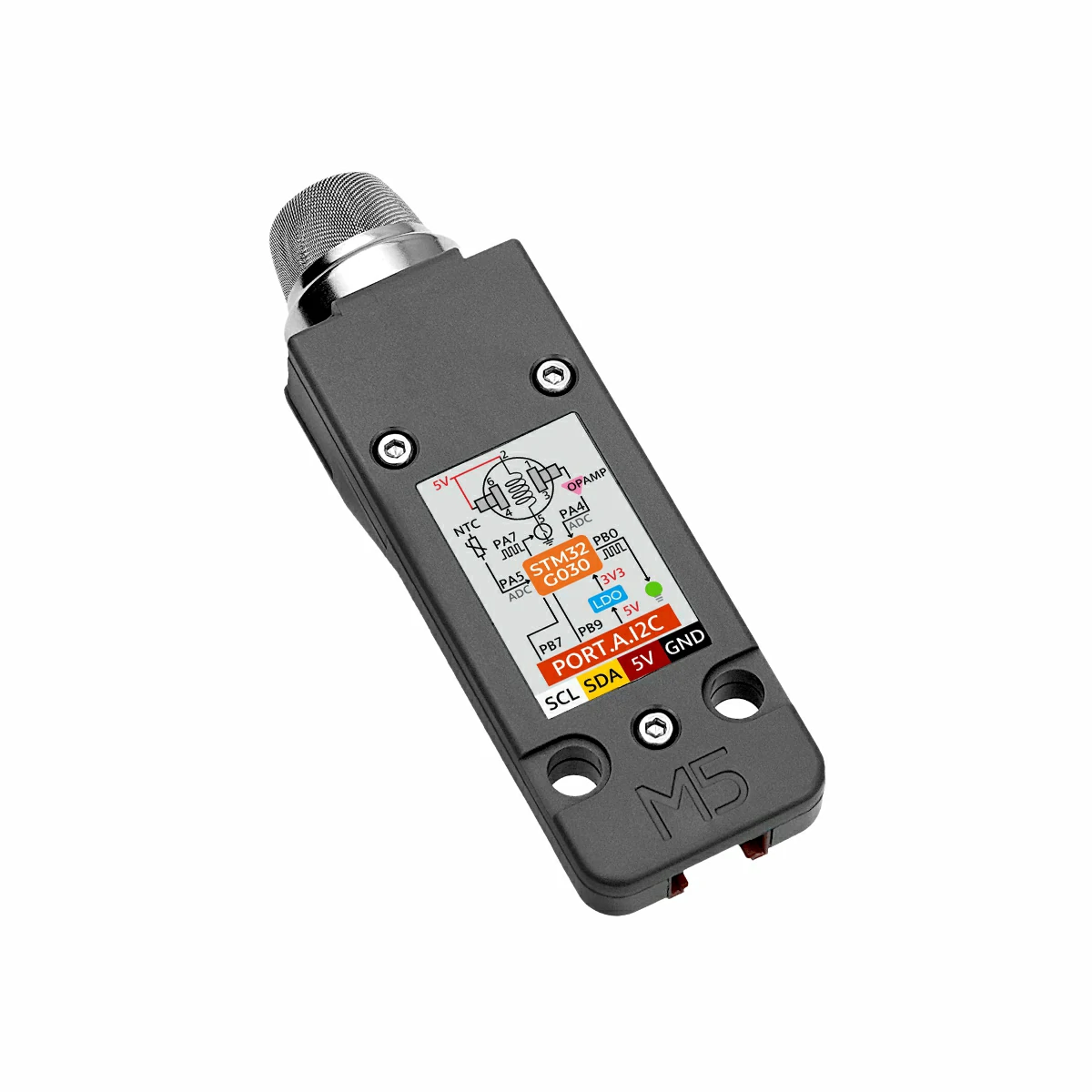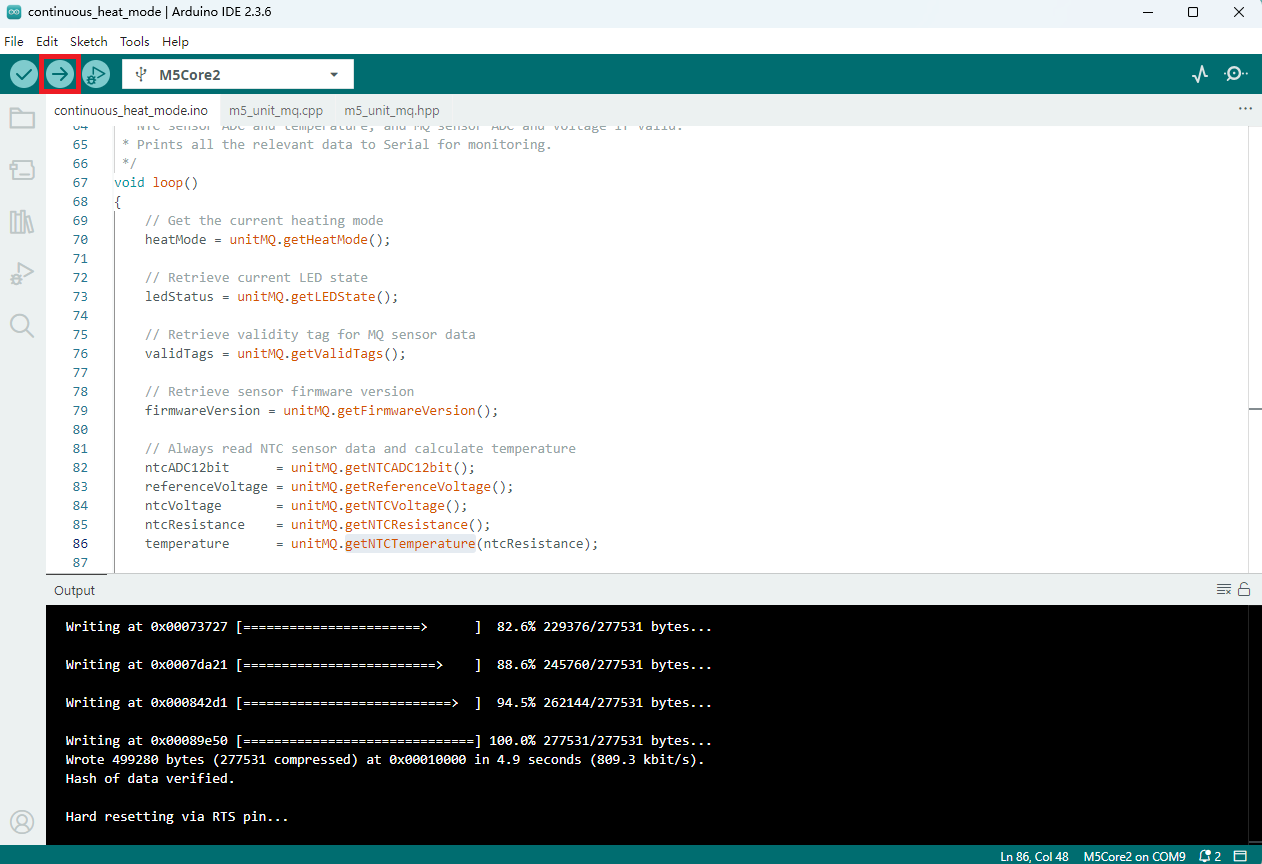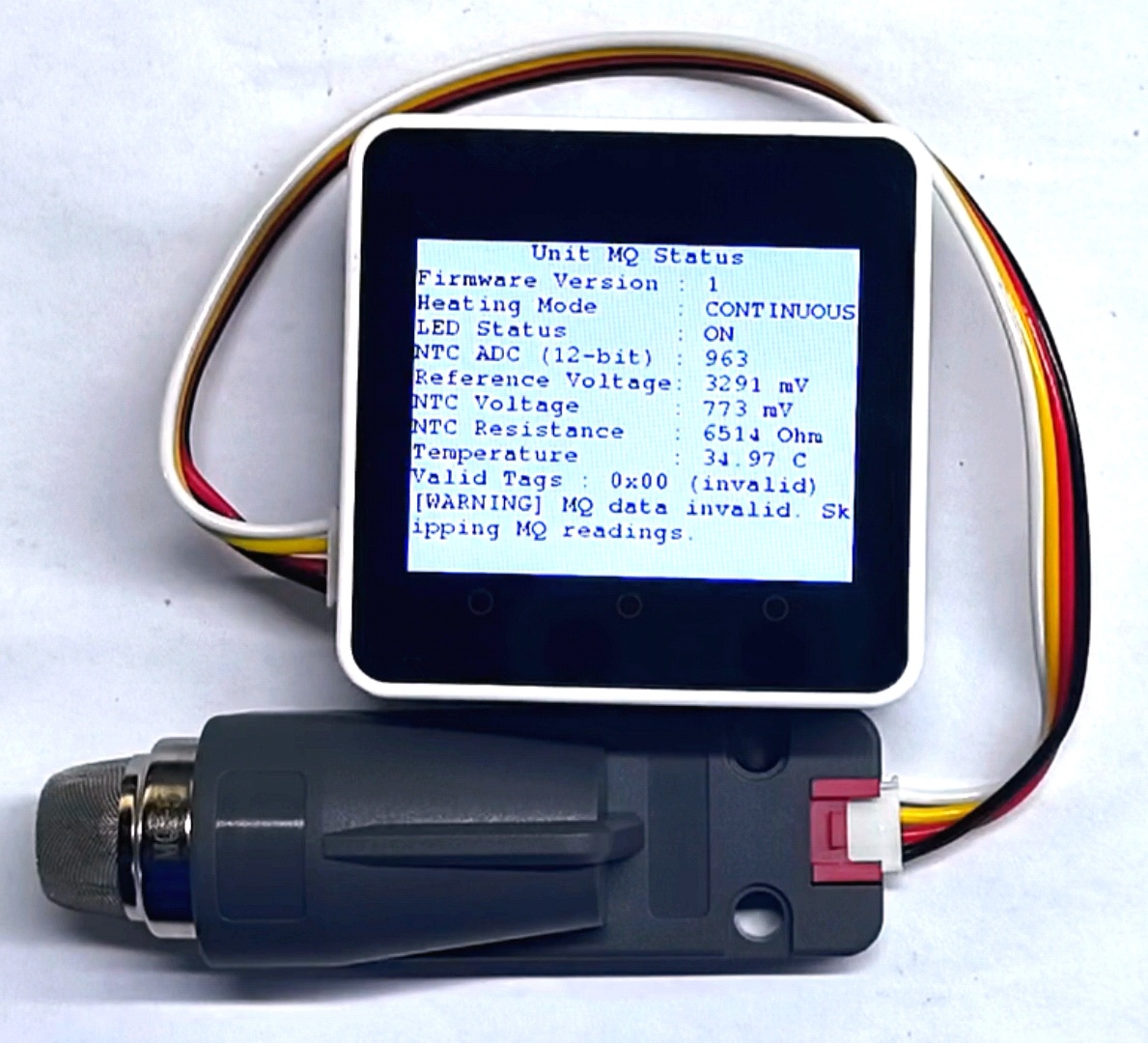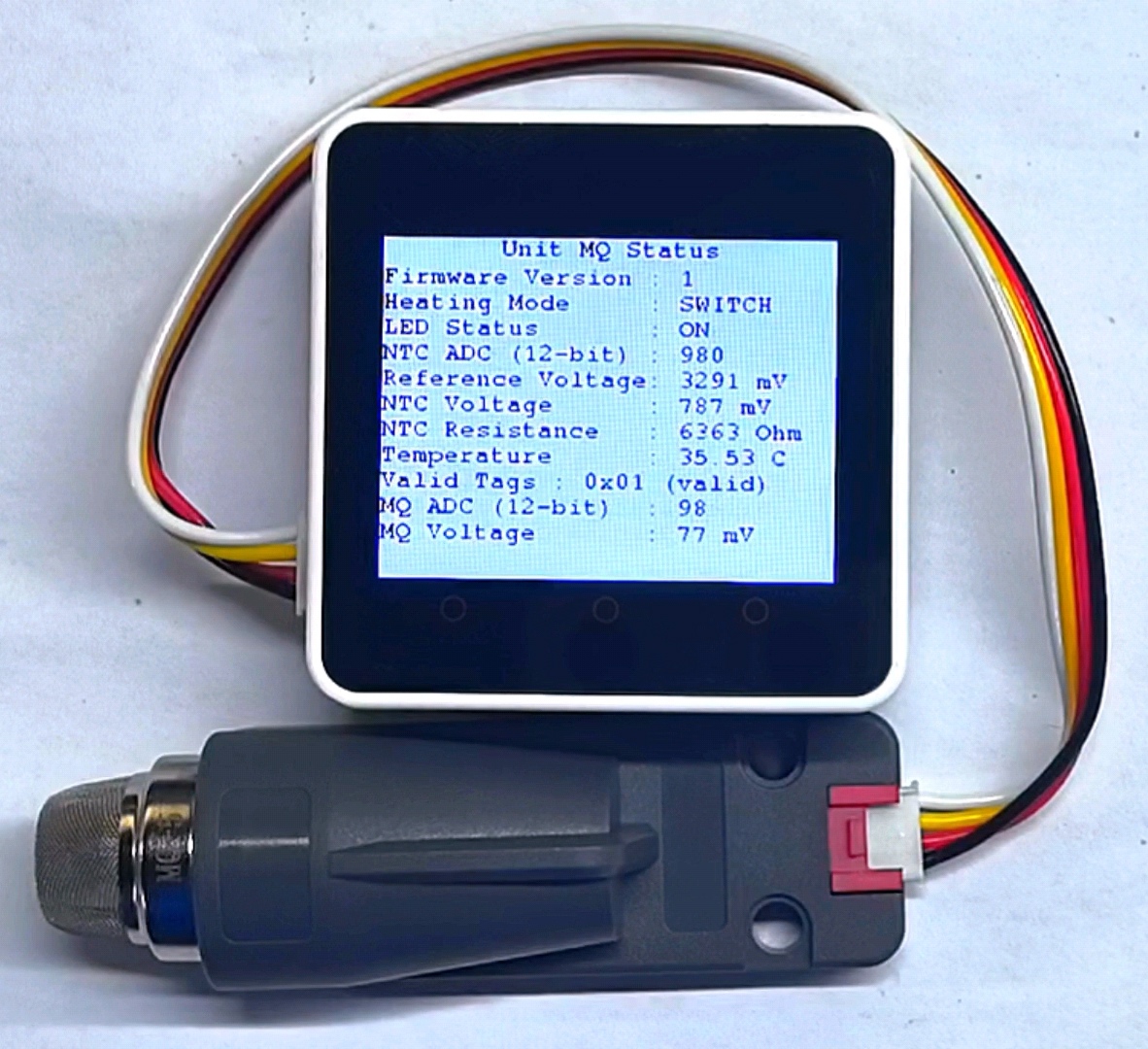Unit MQ Arduino 使用教程
1. 准备工作
环境配置: 参考 Arduino IDE 上手教程完成 IDE 安装,并根据实际使用的开发板安装对应的板管理,与需要的驱动库。
使用到的驱动库:
使用到的硬件产品:


2. 注意事项
引脚兼容性
由于每款主机的引脚配置不同,为了让用户更方便地使用,M5Stack 官方提供了引脚兼容性表,方便用户查看,请根据实际引脚连接情况修改案例程序。
3. 案例程序
本教程中使用的主控设备为 Core2 v1.1 ,搭配 Unit MQ。本电流电压检测单元采用 I2C 的方式通讯,根据实际的电路连接修改程序中的引脚定义,设备连接后对应的 I2C 引脚为 G33 (SCL),G32 (SDA)。
说明
- Unit MQ 可配置两种加热模式:连续加热模式(
HEAT_MODE_CONTINUOUS)和间歇加热模式(HEAT_MODE_PIN_SWITCH),能够获取的数据有传感器电压、ADC参考电压、设备温度等,可根据需要选用。 - 数据获取 API 如下:
getValidTags() // Data Valid Tag
getReferenceVoltage() // Reference Voltage
getNTCADC12bit() // NTC ADC
getNTCVoltage() // NTC Voltage
getNTCResistance() // NTC Resistance
getNTCTemperature(uint16_t ntcResistance) // NTC Temperature
getMQADC12bit() // Sensor ADC
getMQVoltage() // Sensor Voltage 连续加热模式
cpp
1 2 3 4 5 6 7 8 9 10 11 12 13 14 15 16 17 18 19 20 21 22 23 24 25 26 27 28 29 30 31 32 33 34 35 36 37 38 39 40 41 42 43 44 45 46 47 48 49 50 51 52 53 54 55 56 57 58 59 60 61 62 63 64 65 66 67 68 69 70 71 72 73 74 75 76 77 78 79 80 81 82 83 84 85 86 87 88 89 90 91 92 93 94 95 96 97 98 99 100 101 102 103 104 105 106 107 108 109 110 111 112 113 114 115 116 117 118 119 120 121 122 123 124 125 126 127 128 129 130 131 132 133 134
#include <M5Unified.h>
#include <M5GFX.h>
#include "m5_unit_mq.hpp"
#define I2C_SDA (32) /**< I2C SDA pin number */
#define I2C_SCL (33) /**< I2C SCL pin number */
#define I2C_SPEED (400000) /**< I2C bus speed in Hz */
M5UnitMQ unitMQ; /**< Instance of the Unit MQ gas sensor */
/* Sensor status and data variables */
static led_status_t ledStatus = LED_WORK_STATUS_OFF; /**< Current LED state */
static heat_mode_t heatMode = HEAT_MODE_CONTINUOUS; /**< Current heating mode */
static mq_adc_valid_tags_t validTags = VALID_TAG_INVALID; /**< MQ ADC data validity flag */
static uint8_t highLevelTime = 0; /**< High-level heating time (not used here) */
static uint8_t lowLevelTime = 0; /**< Low-level heating time (not used here) */
static uint16_t mqADC12bit = 0; /**< MQ sensor raw ADC value (12-bit) */
static uint16_t ntcADC12bit = 0; /**< NTC sensor raw ADC value (12-bit) */
static uint16_t ntcResistance = 0; /**< Calculated NTC resistance in Ohms */
static uint16_t referenceVoltage = 0; /**< Reference voltage in millivolts */
static uint16_t mqVoltage = 0; /**< Calculated MQ sensor voltage in millivolts */
static uint16_t ntcVoltage = 0; /**< Calculated NTC sensor voltage in millivolts */
float temperature = 0.0f; /**< Calculated temperature in degrees Celsius */
static uint8_t firmwareVersion = 0; /**< Sensor firmware version */
/**
* @brief Arduino setup function, runs once at startup.
*
* Initializes the M5 hardware and Unit MQ sensor with I2C configuration.
* Retries sensor initialization until successful.
* Sets sensor heating mode and turns on the sensor LED.
*/
void setup()
{
M5.begin();
M5.Display.setRotation(1);
M5.Display.clear(TFT_WHITE);
M5.Display.setFont(&fonts::FreeMonoBold9pt7b);
M5.Display.setTextColor(TFT_BLACK);
Serial.begin(115200);
Serial.println("========== Unit MQ Initialization ==========");
// Initialize Unit MQ sensor on I2C bus, retry until success
while (!unitMQ.begin(&Wire, UNIT_MQ_I2C_BASE_ADDR, I2C_SDA, I2C_SCL, I2C_SPEED)) {
Serial.println("[ERROR] Unit MQ initialization failed! Retrying...");
delay(1000);
}
Serial.println("[INFO] Unit MQ initialization succeeded.");
// Set the heating mode to continuous heating
unitMQ.setHeatMode(HEAT_MODE_CONTINUOUS);
Serial.println("[INFO] Heating mode set to CONTINUOUS.");
// Turn on the sensor's LED indicator
unitMQ.setLEDState(LED_WORK_STATUS_ON);
Serial.println("[INFO] LED status set to ON.");
}
/**
* @brief Arduino main loop function, runs repeatedly.
*
* Reads sensor data including LED status, valid tags, firmware version,
* NTC sensor ADC and temperature, and MQ sensor ADC and voltage if valid.
* Prints all the relevant data to Serial for monitoring.
*/
void loop()
{
// Get the current heating mode
heatMode = unitMQ.getHeatMode();
// Retrieve current LED state
ledStatus = unitMQ.getLEDState();
// Retrieve validity tag for MQ sensor data
validTags = unitMQ.getValidTags();
// Retrieve sensor firmware version
firmwareVersion = unitMQ.getFirmwareVersion();
// Always read NTC sensor data and calculate temperature
ntcADC12bit = unitMQ.getNTCADC12bit();
referenceVoltage = unitMQ.getReferenceVoltage();
ntcVoltage = unitMQ.getNTCVoltage();
ntcResistance = unitMQ.getNTCResistance();
temperature = unitMQ.getNTCTemperature(ntcResistance);
// Print sensor status and readings
Serial.println("======== Unit MQ Status ========");
Serial.printf("Firmware Version : %d\n", firmwareVersion);
Serial.printf("Heating Mode : %s\n", heatMode == HEAT_MODE_CONTINUOUS ? "CONTINUOUS" : "SWITCH");
Serial.printf("LED Status : %s\n", ledStatus == LED_WORK_STATUS_ON ? "ON" : "OFF");
Serial.printf("NTC ADC (12-bit) : %u\n", ntcADC12bit);
Serial.printf("Reference Voltage : %u mV\n", referenceVoltage);
Serial.printf("NTC Voltage : %u mV\n", ntcVoltage);
Serial.printf("NTC Resistance : %u Ohm\n", ntcResistance);
Serial.printf("Temperature : %.2f °C\n", temperature);
M5.Display.clear(TFT_WHITE);
M5.Display.drawCenterString("Unit MQ Status", M5.Display.width()/2, 0);
M5.Display.setCursor(0, 20);
M5.Display.printf("Firmware Version : %d\n", firmwareVersion);
M5.Display.printf("Heating Mode : %s\n", heatMode == HEAT_MODE_CONTINUOUS ? "CONTINUOUS" : "SWITCH");
M5.Display.printf("LED Status : %s\n", ledStatus == LED_WORK_STATUS_ON ? "ON" : "OFF");
M5.Display.printf("NTC ADC (12-bit) : %u\n", ntcADC12bit);
M5.Display.printf("Reference Voltage: %u mV\n", referenceVoltage);
M5.Display.printf("NTC Voltage : %u mV\n", ntcVoltage);
M5.Display.printf("NTC Resistance : %u Ohm\n", ntcResistance);
M5.Display.printf("Temperature : %.2f C\n", temperature);
// Print MQ sensor readings only if data is valid
if (validTags == VALID_TAG_VALID) {
mqADC12bit = unitMQ.getMQADC12bit();
mqVoltage = unitMQ.getMQVoltage();
Serial.printf("Valid Tags : 0x%02X (MQ data valid)\n", validTags);
Serial.printf("MQ ADC (12-bit) : %u\n", mqADC12bit);
Serial.printf("MQ Voltage : %u mV\n", mqVoltage);
M5.Display.printf("Valid Tags : 0x%02X (valid)\n", validTags);
M5.Display.printf("MQ ADC (12-bit) : %u\n", mqADC12bit);
M5.Display.printf("MQ Voltage : %u mV\n", mqVoltage);
} else {
Serial.printf("Valid Tags : 0x%02X (MQ data invalid)\n", validTags);
Serial.println("[WARNING] MQ data invalid. Skipping MQ readings.");
M5.Display.printf("Valid Tags : 0x%02X (invalid)\n", validTags);
M5.Display.println("[WARNING] MQ data invalid. Skipping MQ readings.");
}
Serial.println("================================\n");
delay(1000); // Delay 1 second before next reading
}间歇加热模式
cpp
1 2 3 4 5 6 7 8 9 10 11 12 13 14 15 16 17 18 19 20 21 22 23 24 25 26 27 28 29 30 31 32 33 34 35 36 37 38 39 40 41 42 43 44 45 46 47 48 49 50 51 52 53 54 55 56 57 58 59 60 61 62 63 64 65 66 67 68 69 70 71 72 73 74 75 76 77 78 79 80 81 82 83 84 85 86 87 88 89 90 91 92 93 94 95 96 97 98 99 100 101 102 103 104 105 106 107 108 109 110 111 112 113 114 115 116 117 118 119 120 121 122 123 124 125 126 127 128 129 130
#include <M5Unified.h>
#include <M5GFX.H>
#include "m5_unit_mq.hpp"
#define I2C_SDA (32) /**< I2C SDA pin number */
#define I2C_SCL (33) /**< I2C SCL pin number */
#define I2C_SPEED (400000) /**< I2C bus speed in Hz */
#define HIGH_LEVEL_TIME (30) /**< High level duration for pin switch mode in seconds */
#define LOW_LEVEL_TIME (10) /**< Low level duration for pin switch mode in seconds */
M5UnitMQ unitMQ; /**< Instance of the Unit MQ gas sensor class */
/* Sensor and system state variables */
static led_status_t ledStatus = LED_WORK_STATUS_OFF; /**< Current LED status */
static heat_mode_t heatMode = HEAT_MODE_PIN_SWITCH; /**< Heating mode of the sensor */
static mq_adc_valid_tags_t validTags = VALID_TAG_INVALID; /**< Validity tag for MQ sensor ADC data */
static uint8_t highLevelTime = 0; /**< High-level time setting for pin switch heating */
static uint8_t lowLevelTime = 0; /**< Low-level time setting for pin switch heating */
static uint16_t mqAdc12bit = 0; /**< Raw 12-bit ADC reading from MQ sensor */
static uint16_t ntcAdc12bit = 0; /**< Raw 12-bit ADC reading from NTC temperature sensor */
static uint16_t ntcResistance = 0; /**< Calculated resistance of NTC sensor (Ohms) */
static uint16_t referenceVoltage = 0; /**< Reference voltage value (mV) */
static uint16_t mqVoltage = 0; /**< Calculated voltage of MQ sensor output (mV) */
static uint16_t ntcVoltage = 0; /**< Calculated voltage of NTC sensor output (mV) */
float temperature = 0.0f; /**< Calculated temperature in Celsius */
static uint8_t firmwareVersion = 0; /**< Firmware version of the Unit MQ sensor */
void setup()
{
M5.begin();
M5.Display.setRotation(1);
M5.Display.clear(TFT_WHITE);
M5.Display.setFont(&fonts::FreeMonoBold9pt7b);
M5.Display.setTextColor(TFT_BLACK);
Serial.begin(115200);
Serial.println("========== Unit MQ Initialization ==========");
// Initialize the Unit MQ sensor with I2C settings.
// Retry initialization until successful.
while (!unitMQ.begin(&Wire, UNIT_MQ_I2C_BASE_ADDR, I2C_SDA, I2C_SCL, I2C_SPEED)) {
Serial.println("[ERROR] Unit MQ initialization failed! Retrying...");
delay(1000);
}
Serial.println("[INFO] Unit MQ initialization succeeded.");
// Set heating mode to PIN SWITCH mode, which alternates heating between HIGH and LOW levels.
unitMQ.setHeatMode(HEAT_MODE_PIN_SWITCH);
Serial.println("[INFO] Heating mode set to PIN SWITCH mode.");
// Configure the durations for high and low heating levels in PIN SWITCH mode.
unitMQ.setPulseTime(HIGH_LEVEL_TIME, LOW_LEVEL_TIME);
Serial.println("[INFO] Pin level switch time set to 30s HIGH and 5s LOW.");
// Turn on the sensor LED indicator.
unitMQ.setLEDState(LED_WORK_STATUS_ON);
Serial.println("[INFO] LED status set to ON.");
}
void loop()
{
// Get the current heating mode
heatMode = unitMQ.getHeatMode();
// Read the current LED status from the sensor.
ledStatus = unitMQ.getLEDState();
// Retrieve validity tag indicating whether MQ sensor data is reliable.
validTags = unitMQ.getValidTags();
// Get the firmware version from the sensor.
firmwareVersion = unitMQ.getFirmwareVersion();
// Always read NTC-related sensor data regardless of MQ data validity.
ntcAdc12bit = unitMQ.getNTCADC12bit(); // Raw ADC for NTC sensor
referenceVoltage = unitMQ.getReferenceVoltage(); // Reference voltage for ADC
ntcVoltage = unitMQ.getNTCVoltage(); // Calculated voltage across NTC
ntcResistance = unitMQ.getNTCResistance(); // Calculated resistance of NTC thermistor
temperature = unitMQ.getNTCTemperature(ntcResistance); // Convert resistance to temperature
Serial.println("======== Unit MQ Status ========");
Serial.printf("Firmware Version : %d\n", firmwareVersion);
Serial.printf("Heating Mode : %s\n", heatMode == HEAT_MODE_CONTINUOUS ? "CONTINUOUS" : "SWITCH");
Serial.printf("LED Status : %s\n", ledStatus == LED_WORK_STATUS_ON ? "ON" : "OFF");
// Print detailed NTC sensor parameters
Serial.printf("NTC ADC (12-bit) : %u\n", ntcAdc12bit);
Serial.printf("Reference Voltage : %u mV\n", referenceVoltage);
Serial.printf("NTC Voltage : %u mV\n", ntcVoltage);
Serial.printf("NTC Resistance : %u Ohm\n", ntcResistance);
Serial.printf("Temperature : %.2f °C\n", temperature);
M5.Display.clear(TFT_WHITE);
M5.Display.drawCenterString("Unit MQ Status", M5.Display.width()/2, 0);
M5.Display.setCursor(0, 20);
M5.Display.printf("Firmware Version : %d\n", firmwareVersion);
M5.Display.printf("Heating Mode : %s\n", heatMode == HEAT_MODE_CONTINUOUS ? "CONTINUOUS" : "SWITCH");
M5.Display.printf("LED Status : %s\n", ledStatus == LED_WORK_STATUS_ON ? "ON" : "OFF");
M5.Display.printf("NTC ADC (12-bit) : %u\n", ntcAdc12bit);
M5.Display.printf("Reference Voltage: %u mV\n", referenceVoltage);
M5.Display.printf("NTC Voltage : %u mV\n", ntcVoltage);
M5.Display.printf("NTC Resistance : %u Ohm\n", ntcResistance);
M5.Display.printf("Temperature : %.2f C\n", temperature);
// If MQ sensor data is valid, read and print MQ ADC and voltage values.
if (validTags == VALID_TAG_VALID) {
mqAdc12bit = unitMQ.getMQADC12bit();
mqVoltage = unitMQ.getMQVoltage();
Serial.printf("Valid Tags : 0x%02X (MQ data valid)\n", validTags);
Serial.printf("MQ ADC (12-bit) : %u\n", mqAdc12bit);
Serial.printf("MQ Voltage : %u mV\n", mqVoltage);
M5.Display.printf("Valid Tags : 0x%02X (valid)\n", validTags);
M5.Display.printf("MQ ADC (12-bit) : %u\n", mqAdc12bit);
M5.Display.printf("MQ Voltage : %u mV\n", mqVoltage);
} else {
// If MQ data is invalid, log a warning and skip readings.
Serial.printf("Valid Tags : 0x%02X (MQ data invalid)\n", validTags);
Serial.println("[WARNING] MQ data invalid. Skipping MQ readings.");
M5.Display.printf("Valid Tags : 0x%02X (invalid)\n", validTags);
M5.Display.println("[WARNING] MQ data invalid.\nSkipping MQ readings.");
}
Serial.println("================================\n");
delay(1000); // Wait for 1 second before next update
}4. 编译上传
- 选中设备端口(详情请参考 程序编译与烧录),点击 Arduino IDE 左上角编译上传按钮,等待程序完成编译并上传至设备。

5. 测量结果
Unit MQ 两种模式效果如下所示:
连续加热模式

间歇加热模式

